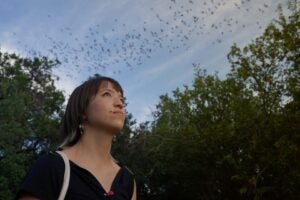AUSTIN, Texas—The origin of word forms in infants is determined by simple mechanics not by speech specific genes, according to a new study by researchers at The University of Texas at Austin. The researchers also found a strong relationship between how infants acquire speech motor control and the origins of speech production skills in early man.
Their conclusion is in stark contrast to the work of other scholars, including world renowned linguist Noam Chomsky, who believes that humans have an innate capacity for learning language — genes playing an important role.
The findings of Dr. Peter F. MacNeilage, professor of psychology, and Dr. Barbara L. Davis, an associate professor of communication sciences and disorders, will be published in the April 21 issue of Science magazine.
Their research shows that there are four patterns (consonant-vowel combinations) common to babies’ babbling and first words in several languages. These include lip consonant-central vowels (mama), tongue front consonants-front vowels (dada ) and tongue back consonants-back vowels (gogo). The fourth pattern is an preference for starting words with a lip consonant-vowel-tongue-front consonant sequence. (i.e. “mad,” which has a lip consonant followed by a vowel, then a tongue-front consonant.)
“These patterns, created by basic open and close movements of the mouth and jaw during speech, indicate that purely physical effects may be more important to the creation of conceptual language than previously thought,” said MacNeilage and Davis.
The researchers also compared these patterns to the structure of a group of “proto-words,” the hypothetical original words that linguists have reconstructed from comparisons of modern language.
“The first words of human ancestors were like the first words of modern infants. Infants show us a picture of what speech may have been like at its simplest,” said Davis. “We believe the first ancestral speakers were using basic mechanical patterns to form spoken words.”
According to the researchers, the most basic unit of language is the word — the minimal stand-alone pairing of meaning and sound structure. But what is the nature of this pairing, they asked. Are there determining factors inherent in the very production of the sound structure of words, beyond their well-known tendency to alternate between consonants and vowels, thus forming syllables?
“Oddly, scant attention has been paid to how the spoken forms of words originated,” said MacNeilage.
Modern adult speakers produce complex strings of speech sounds in varied combinations to express ideas, the University scholars explained. In contrast, infants begin to produce speech-like output in babbling at about 8 months old, but are unable to manage the complexities of mature speech production for two to three years.
“Although it is widely conceded that the problems infants show in acquiring correct speech are primarily motor control problems rather than perceptual problems, there has been little effort to develop a coherent theory of acquisition of speech motor control,” they said.
MacNeilage and Davis conducted statistical studies of the babbling of six infants and the first words of 10 infants in an English-speaking environment. The infants, ages six to 18 months, had tiny microphones (with remote tape recorders) pinned to their bibs.
“We wanted to get the microphone as close to the mouth as possible so we could pick up all their sounds,” said Davis, adding that every speech-like sound was recorded, then transcribed into phonetic symbols. These different sounds occur depending on the location of the tongue when the infant opens and closes her mouth. Consonants are produced when the mouth is closed and vowels are produced when the mouth opens.
The same four resulting patterns emerged in additional studies of French, Swedish and Japanese infants, as well as infants in an Ecuadorian-Quichua environment and in a Brazilian-Portuguese environment. “Babbling, and to a lesser extent, first words tend to be similar across cultures, so these patterns may indeed be virtually universal in infants,” the researchers concluded.
The UT researchers also split with traditional linguists on the theory of how far back the origin of language can be traced. “Traditional linguists believe you can’t go back more than 5,000 years, said MacNeilage. “A maverick school of thought, however, is that you can reconstruct this well beyond 5,000 years — maybe to even 100,000 years ago. We are aligning ourselves with this group.”
MacNeilage will present their research at the International Congress of Psychology in July in Stockholm, Sweden.
NOTE TO EDITORS: MacNeilage can be reached at (512) 475-7009 and Davis at (512) 471-1929. For photographs, contact Marsha Miller at (512) 471-6412 or email her at marsha@opa.wwh.utexas.edu or visit the OPA Website at www.utexas.edu/admin/opa/news/00newsreleases/nr_200004/nr_speech2.html



